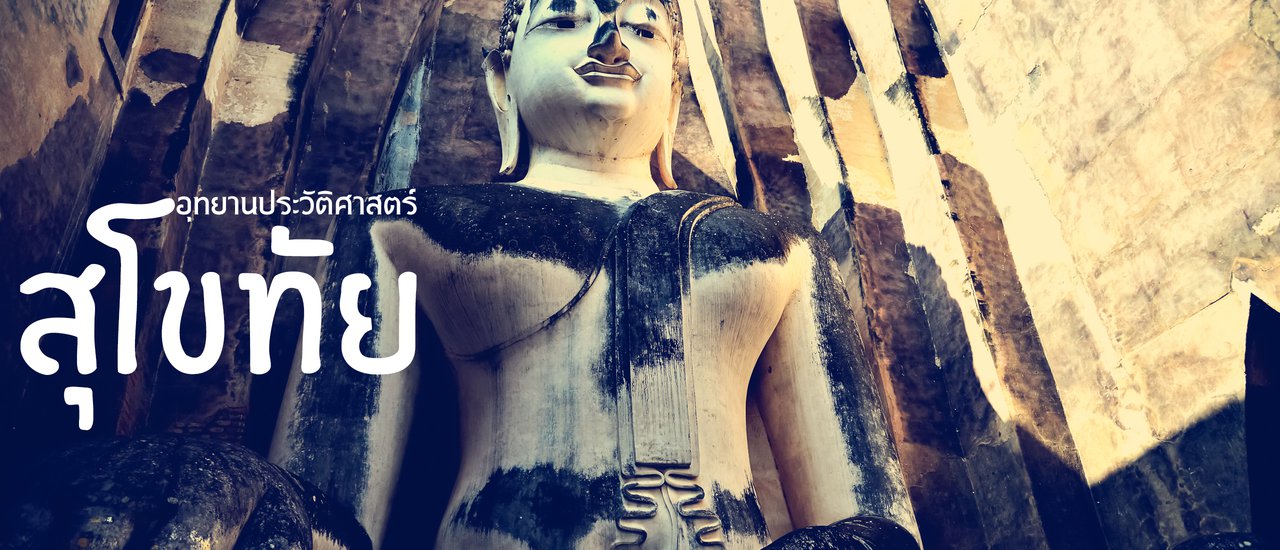While I may not have traveled the world extensively, I can confidently say that Thailand boasts numerous stunning locations that rival those found abroad. This is precisely why many international tourists choose Thailand as their destination. For Thai citizens, domestic travel is even more convenient. With a car, you can practically reach any corner of the country. Although our railway system may not compare to those in Europe or Japan, our road network is highly regarded, ranking as the best in the ASEAN region. So, let's embark on a journey to explore the wonders of Thailand.


News broke recently that the tunnel behind the main Buddha statue at Wat Si Chum has been opened for the first time in 30 years, allowing visitors to climb to the top and capture the classic view of the temple. Having visited the temple twice myself, I know I missed this opportunity. Today, I'd like to dust off some photos from my trip to Sukhothai Historical Park last year and take you on a virtual tour. This time, we'll also explore a few ancient sites outside the city walls, which offer equally stunning and unique beauty.
Visitors to Sukhothai Historical Park will receive a map that serves as a guide to the ruins. Most of the ancient ruins are located within the walls that define the boundaries of the ancient city. The majority of tourists enter through the west gate, which is a straight road that connects directly to Sukhothai town. Before visiting, let's learn some basic information about the park.



The Sukhothai Historical Park encompasses the area that was the city of Sukhothai, the first city in the historical era that is considered to be the city where the Thai people were able to unite as a kingdom over 700 years ago. It was a contemporary of the Lanna city of Chiang Mai and the city of Phayao, which were able to break away from the Khmer Empire of Cambodia. The factors behind the establishment of a new kingdom in this area amidst the major powers of the West, namely the Burmese Pagan, the Mon Khmer to the south, and the Annam Kingdom of ancient Vietnam to the east, was that it was located in the middle of these three power centers. This was because the greatest empire in the world at that time, the Yuan Empire or the Mongol Empire, led by Kublai Khan, the grandson of Genghis Khan, posed a threat to the north of the three kingdoms. After the Mongols conquered the Jin and Southern Song empires and took control of the entire Chinese mainland, they marched their armies to prepare to conquer the Burmese Pagan and Annam Vietnam, as well as Champa and Khmer. The Thai kingdom in the middle was thus born in the middle, and it also carried out skillful diplomacy during the reign of King Ramkhamhaeng, the third greatest king in the history of Sukhothai, by pursuing a foreign policy of the highest order. This involved establishing an ancient alliance, or rather, a federation of cooperation between Lanna and Phayao to resist the Mongol invasion. Since Sukhothai was located in the middle, it was better to make Lanna and Phayao buffer states against the Mongols. However, the three small allied states knew very well that the Turkic Mongol army had conquered the whole world. How could the three small states possibly resist? Even the Burmese Pagan Empire, which had previously defeated China and ruled Yunnan, was utterly defeated by the Mongol army. The upper part of Lanna was also lost to the Mongols, such as the Twelve Panna. The three states therefore changed their policy to that of a tributary state, accepting the Mongols as their elder brother instead of China. This gradually led to the region becoming a land of peace and lasting peace, living up to the name of the kingdom, "Sukhothai," which means "dawn of happiness." It was just like that.

Sukhothai lives up to its name as a slow-paced city that is not outdated. It is best visited in conjunction with Si Satchanalai, which is even older than Sukhothai. Both cities offer a vintage atmosphere that will leave you breathless. However, Sukhothai has grown significantly, with shopping malls, cinemas, and nightlife. Despite this, most of the city retains its peaceful beauty. After 7 pm, it becomes quiet, and during the winter, it gets dark even earlier. Anyone who visits or lives in Sukhothai will undoubtedly fall in love with this small, ancient city. However, during the hot season, Sukhothai can be scorching. It was the hottest province in Thailand last April. During the rainy season, flooding is a common occurrence. Let's go on a trip and stop digressing.



From Wat Chetuphon, we drove straight to the outer city wall at Na Mo Gate, exiting through Ao Gate to the west to visit some ancient sites in that area. The first point we passed was Wat Tuk. The ancient site of Wat Tuk is located in the western part, which is adjacent to Khao Luang and is considered the highest point of the ancient city of Sukhothai, situated on a hill. There is no evidence or documentation about this temple, except for the stucco mandapa depicting the story of the Buddha's return from Tavatimsa heaven after preaching to his mother.

Beyond the city walls, there are many more ancient sites. It would take a whole day to visit them all. These include the Deva Shrine, Pa Mamuang Temple, Traphang Chang Phuak Temple, Mangkon Temple, Tha Temple, Chang Rop Temple, Aranyik Temple, and Khao Phra Bat Noi Temple. From the map, it seems like these temples are close together, but it actually takes quite a while to walk to each one. Foreigners seem to enjoy cycling around the area, while some sit and sketch. As for me, I prefer to drive, as it's quite hot.
To the west, bordering Tak Province, lies a significant highlight that will test your endurance and leg strength. This is Wat Saphan Hin, a temple requiring a climb up a slightly steep hill. Wat Saphan Hin, also known as Wat Saphan Hin, is located in an area called Aranyawasi, or "forest temple" (temples within the city are called Wat Khamwesi). It sits atop a hill approximately 200 meters high. The ascent to the temple involves a 300-meter climb on a path paved with slate stones.

On the hilltop temple grounds, a small, unopened lotus bud-shaped stupa stands. A dilapidated sandstone chapel reveals a Buddha statue in the posture of granting forgiveness, whose beauty rivals that of the Buddha statues in the city's Maha That Temple. This statue, known as Phra Attharasa, is a highlight of temples outside the city walls. It exemplifies the Sri Lankan style of Buddhist art, characterized by tall standing Buddha statues, prevalent in Sukhothai, Si Satchanalai, and Phitsanulok. Phra Attharasa follows the Sri Lankan tradition of depicting the Buddha as 18 cubits tall. Saphan Hin Temple is believed to be the site where King Ramkhamhaeng the Great ascended the Milky Way elephant, Ruja Kiri, to pay homage to the Buddha every 15th waning moon. From the temple grounds, gaze upon the city of Sukhothai and imagine what it must have been like 700 years ago.
The route north from the western wall of the city is significant, connecting to the ancient city of Si Satchanalai and extending to Lampang and Chiang Mai. This historical route is home to Wat Sri Chum, a prominent landmark often featured in travel magazines.


Modern history has concluded that the name "Sri Chum" comes from the word "Phuen Mueang," which means "bodhi tree" because the temple is surrounded by bodhi trees. However, during the Ayutthaya period, no one knew this word, so it is assumed that it was a temple where many hermits lived. Wat Sri Chum was built during the reign of King Ramkhamhaeng because the name of the principal Buddha image in the mondop is Phra Achana, a large and impressive Buddha statue in the Mara-Vijaya posture that attracts tourists to visit it every day. The first inscription states that "Phra Achana is located at the foot of the city of Sukhothai (west)." The roof of the mondop has collapsed, leaving the Buddha statue sitting in the open air. On the walls, there are still faint traces of carved Buddha Jataka stories, which are considered to be the oldest Thai paintings.
Despite its dilapidated state, Wat Sri Chum is not an abandoned temple. People have been paying respects here since ancient times. According to legend, when King Naresuan the Great was about to lead his army to attack the city of Chiang Saen (Sukhothai), which refused to join Thailand after his declaration of independence from Burma, he gathered his troops at Wat Sri Chum before attacking the city. However, this battle was against fellow Thais, and the soldiers were not motivated to fight. The king devised a plan to have one of his soldiers climb behind the Buddha statue and speak words of encouragement to the troops, giving rise to the legend of the talking Buddha of Wat Sri Chum that continues to this day.
The current appearance of Phra Achana Buddha statue is attributed to the restoration project initiated by His Majesty King Bhumibol Adulyadej in 1952. Professor Silpa Bhirasri, an Italian architect, played a pivotal role in this project, leading to the statue's present splendor. Wat Si Chum is also renowned for the discovery of the second inscription stone, which details the history of the Phra Ruang and Pha Mueang dynasties, as well as the founding of Sukhothai. This discovery effectively debunked the conspiracy theory that the first inscription stone was a forgery.

We enter the city walls through the Sala Luang Gate and park our car near the King Ramkhamhaeng Monument. From there, we walk to other historical sites. The largest in this zone is Wat Sa Si, which is located in the middle of a lake. Wat Sa Si was built around the 19th-20th centuries and is situated in the middle of the largest pond, called Traphang Trakuan. At Wat Sa Si, there is a Sri Lankan-style stupa, which is clear evidence that Sukhothai received Buddhist influences from Sri Lanka (while the Khmer and Mon in the south were Hindu). The ordination hall in the middle of the pond reflects the Buddhist belief that water is pure and separates the monks from the laity. This is called Uthok Sima.






Opposite Wat Traphang Ngoen is the most important historical site located in the center of Sukhothai and adjacent to what is believed to be the ancient royal palace. This is Wat Mahathat, a temple situated precisely in the middle of the city. It is believed to have been built as a temple alongside the city's founding during the establishment of the Sukhothai Kingdom by King Sri Indraditya. The temple complex comprises walls and a surrounding moat. The main stupa is a bell-shaped stupa, a hallmark of pure Sukhothai art created by true Sukhothai artisans. (This style of stupa can also be found in Lamphun and Lamphang.) This stupa was built in this style to signify the kingdom's independence from Khmer influence and to mark it as the first capital of the Thai kingdom. Around the stupa are four Buddha images, still bearing traces of Khmer art, and stucco reliefs depicting the life of Buddha according to Sri Lankan tradition. There are also numerous smaller stupas surrounding the main stupa, totaling over 200.
The main stupa is flanked by two pavilions housing the Attharasa Buddhas, similar to those seen at Wat Saphan Hin outside the city walls. In front of the main stupa is the Wihan Luang, which, according to the first inscription, housed a large bronze Buddha statue. King Rama I brought this statue to the Wihan Luang at Wat Suthat Thepwararam in present-day Bangkok. To the south of the main stupa is a large five-spired stupa, believed to contain the ashes of King Maha Thammaracha Lithai.











This excerpt describes a visit to Sukhothai, a historical city in Thailand. The author mentions various attractions within the city walls, including ancient ruins and illuminated sights at night. They also note that the city closes earlier on New Year's Day. Additionally, the text mentions a large lake outside the city with a heart-shaped island and a temple dedicated to the city's patron deity. Finally, the author suggests visiting the city's central shrine dedicated to the mother of King Ramkhamhaeng, a revered figure in Thai history.







www.facebook.com/thetravelbagstory
TravelTherapy
Wednesday, October 9, 2024 5:58 PM






















